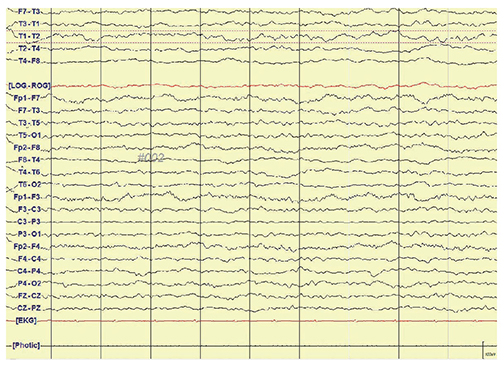Ann Clin Neurophysiol.
2018 Jul;20(2):97-100. 10.14253/acn.2018.20.2.97.
Cefepime-induced nonconvulsive status epilepticus in a hemodialysis patient
- Affiliations
-
- 1Department of Internal Medicine, Inje University Haeundae Paik Hospital, Busan, Korea. parkbong31@naver.com
- 2Department of Neurology, Inje University Haeundae Paik Hospital, Busan, Korea.
- KMID: 2454713
- DOI: http://doi.org/10.14253/acn.2018.20.2.97
Abstract
- Nonconvulsive status epilepticus (NCSE) is an unusual complication in patients treated with cefepime. An 82-year-old woman on maintenance hemodialysis was given cefepime for pneumonia. Her level of consciousness decreased since the administration of cefepime, and she was diagnosed with NCSE based on electroencephalography (EEG) findings. After discontinuation of cefepime, improvement was seen both in the level of consciousness and EEG findings. Clinicians should be aware of cefepime-induced NCSE, particularly in patients with renal failure.
Keyword
MeSH Terms
Figure
Reference
-
1. Delanty N, Vaughan CJ, French JA. Medical causes of seizures. Lancet. 1998; 352:383–390.
Article2. Hirsch LJ, Gaspard N. Status epilepticus. Continuum (Minneap Minn). 2013; 19:767–794.
Article3. Fernández-Torre JL, Martínez-Martínez M, González-Rato J, Maestro I, Alonso I, Rodrigo E, et al. Cephalosporin-induced nonconvulsive status epilepticus: clinical and electroencephalographic features. Epilepsia. 2005; 46:1550–1552.
Article4. Fugate JE, Kalimullah EA, Hocker SE, Clark SL, Wijdicks EF, Rabinstein AA. Cefepime neurotoxicity in the intensive care unit: a cause of severe, underappreciated encephalopathy. Crit Care. 2013; 17:R264.
Article5. Dakdouki GK, Al-Awar GN. Cefepime-induced encephalopathy. Int J Infect Dis. 2004; 8:59–61.
Article6. U.S. Department of Health and Human Services. FDA Drug Safety Communication: cefepime and risk of seizure in patients not receiving dosage adjustments for kidney impairment [Internet]. Rockville (MD, USA): FDA;c2016. accessed 2016 Jan 19. Available from: https://www.fda.gov/Drugs/DrugSafety/ucm309661.htm.7. Sugimoto M, Uchida I, Mashimo T, Yamazaki S, Hatano K, Ikeda F, et al. Evidence for the involvement of GABA(A) receptor blockade in convulsions induced by cephalosporins. Neuropharmacology. 2003; 45:304–314.
Article8. Schliamser SE. Neurotoxicity of beta-lactam antibiotics. Experimental kinetic and neurophysiological studies. Scand J Infect Dis Suppl. 1988; 55:1–61.
- Full Text Links
- Actions
-
Cited
- CITED
-
- Close
- Share
- Similar articles
-
- Cefepime-Induced Nonconvulsive Status Epileticus Presenting as Coma in a Patient with ESRD on Hemodialysis
- Cefepime-induced neurotoxicity
- A Case of Complex Partial Status Epilepticus
- Nonconvulsive Status Epilepticus Associated with Hashimoto's Encephalopathy
- Ceftazidime-Induced Nonconvulsive Status Epilepticus




